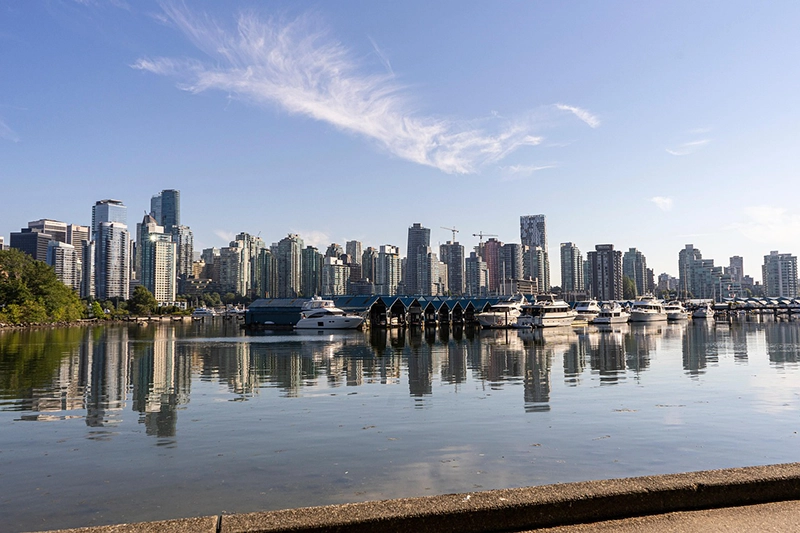Vancouver is home to diverse tree species that flourish under the city’s mild climates. Not all trees are built within urban spaces, though. Some can provide shade, privacy, and added curb appeal, while others can cause property damage and inconvenience.
Choosing the right tree is crucial to creating an outdoor space that complements your home’s appeal and comfort.
This guide lists Vancouver trees you should plant on your side of the fence and those you should keep out of your garden.

USDA Zones of Hardiness
USDA hardiness zones based on climate help us identify which plants—including trees—are most likely to flourish in a given area. Each zone is further separated into “a” and “b” subcategories for further precision. The zones are defined by the average annual lowest winter temperature and comprise 13 zones.
Knowing USDA Hardiness Zones helps gardeners and tree care experts choose tree varieties that survive local winter temperatures. Planting trees fit for the proper zone lowers maintenance requirements, increases survival rates, and stimulates good development.
Best Trees to Plant Near Your House
Japanese Maple (Acer Palmatum)
USDA Hardiness Zones: 5-9
This deciduous tree is famed for its stunning scarlet foliage in the fall. It also has a diminutive stature, growing between 10 to 25 feet, while dwarf varieties can be as small as 4 feet tall.
Combining its aesthetic appeal and compact form, the Japanese maple is an excellent choice for a focal point on your lawn, especially in small gardens.
It also requires moderate maintenance. Japanese maple branches usually grow with a natural, elegant look and don’t need regular pruning. Prune only when needed and water regularly to keep the soil moist.
Flowering Dogwood (Cornus Florida)
USDA Hardiness Zones: 5-9
This ornamental tree blooms with beautiful flowers, and its crown boasts interesting shapes and fantastic autumn hues. Its average mature height is around 30 feet, making it a good source of shade for your home.
When the months of April and May arrive, dogwood trees stand out with their abundance of flowers, which have vibrant bracts of pink or white. In the fall, the leaves become smeared with eye-catching reds and maroons.
This tree can also thrive in partial shade and only needs pruning to remove dead branches. Plant it on moist soil and add mulch around the tree root zone to protect it from the cold climate.
Magnolia (Magnolia spp.)
USDA Hardiness Zones: 4-10
This tree is a pretty addition to your front yard thanks to its big flowers that blossom in early spring.
These batches of pink or white flowers also release a sweet and citrusy fragrance that makes your home’s outdoors even more enticing.
Magnolias’ mature tree size varies depending on the species. The Star Magnolia is a small tree that grows to about 15 feet, while the Southern Magnolia is a larger tree that can reach up to 60 feet tall.
These low-maintenance trees are best planted on well-drained soil under full sun. Occasional pruning is enough, and they should receive enough water regularly.
American Hornbeam (Carpinus Caroliniana)
USDA Hardiness Zones: 3-9
The American Hornbeam is a deciduous shade tree known for its robust construction and resistance to pests and diseases.
Its dark green leaves turn orange and yellow in the fall, while its dark trunk and bare branches sprinkled with snow look great in late winter.
It’s easier to maintain since it grows slowly; consider the space it will occupy at its peak maturity. This tree can thrive under partial to full shade over moist, well-drained soil. Keep it healthy with regular watering in dry summers and, ideally, a layer of mulch for that extra boost.
Worst Trees to Plant Near Your House
Weeping Willow (Salix Babylonica)
USDA Hardiness Zones: 6-8
A weeping willow looming over a house may look fascinating, but owning this tree has drawbacks you don’t want to deal with.
This fast-growing tree is known for its immense size and drooping foliage, which occupy valuable space in your yard. The brittle branches are also prone to breaking, especially during storms and in old age.
It also thrives on wet soil, making it a natural neighbour to lakes and other bodies of water. However, on private property, their invasive roots are usually drawn to water pipes and sewers, causing damage to your home.
Black, Green, and White Ash Trees (Fraxinus spp.)
USDA Hardiness Zones: 2-9
These are medium—to large trees that grow fast, and their leaf colours shift with the changing seasons.
While ash trees offer shade and wildlife habitat, there’s a good reason why you want to avoid getting one for your property.
The emerald ash borer (EAB), the biggest threat to ash trees, is now present in Vancouver. These beetles will start an infestation that can kill the tree in just a few years. Treatments to control these pests will cost you more money, yet you’re still unsure whether your ash tree can survive.
In addition to the EAB issue, these trees also have invasive root systems that can damage homes’ pipes and foundations.
Lombardy Poplar (Populus Nigra Italica)
USDA Hardiness Zones: 3-9
Seeing a Lombardy poplar in its prime might make you think it’s a popular choice for landscaping. However, these slim and tall trees often have short lives and an ugly demise.
They’re vulnerable to canker disease, shortening the tree’s lifespan by 10 to 15 years. This tree also looks unappealing when it wilts, leaving a dull and decrepit snag that still stands tall in your prized garden.
When it’s alive, this tree’s roots can also cause problems, invading your home from underground and damaging pipes in their path.
Hire Tree Planting Experts in Vancouver
Numerous factors must be considered when choosing the type of tree that best suits your property and your preferences.
An expert arborist can remove the complicated guesswork in planting trees.
Devine Arboricultural Solutions is a tree care company in Vancouver, BC, that can help you plant the perfect tree for your home.
We’re your local tree experts certified by the International Society of Arboriculture. We’ll plant the right tree at the right place and time, ensuring that it meets the conditions that drive the best results and make your new tree a worthy investment.
